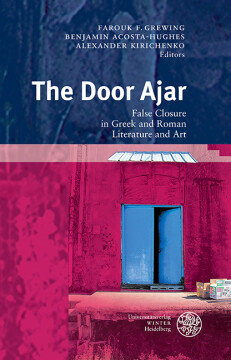
BUCH
The Door Ajar
False Closure in Greek and Roman Literature and Art
Herausgeber: Grewing, Farouk F. | Acosta-Hughes, Benjamin | Kirichenko, Alexander
Bibliothek der klassischen Altertumswissenschaften, Neue Folge, 2. Reihe, Bd. 132
2013
Zusätzliche Informationen
Bibliografische Daten
Abstract
When is “closure” in fact “false closure”, the deceptive opposite of apparent conclusion or perfection? 2009 marked the twentieth anniversary of the publication of Don Fowler's seminal essay “First Thoughts on Closure: Problems and Prospects” (MD 22: 75-122), a work that contributed greatly to bringing about a broad reconsideration in Ancient literary studies of the concept of closure whether understood as an ontological feature, an aesthetic concept, an appreciative inclination on the part of a work's Audience or a psychological desire of the individual to control the “text” at hand. The present volume, ‚The Door Ajar: False Closure in Greek and Roman Literature and Art’, seeks to mark both a debt to the ongoing influence of Fowler’s work, and to frame a future discourse on false closure in particular as an artistic phenomenon.
Inhaltsverzeichnis
| Zwischenüberschrift | Seite | Aktion | Preis |
|---|---|---|---|
| Contents | v | ||
| Acknowledgements | ix | ||
| List of Contributors | xi | ||
| Abbreviations | xv | ||
| List of Illustrations | xvii | ||
| Introduction | 1 | ||
| Is this the End? | 1 | ||
| I. Questioning Closure | 17 | ||
| Francis M. Dunn: Ethical Attachments and the End of Sophocles’ Oedipus the King | 17 | ||
| Christian Kaesser: False Closure and Deception | 29 | ||
| Christopher Whitton: Trapdoors: The Falsity of Closure in Pliny’s Epistles | 43 | ||
| II. Time, Space, and Closure | 63 | ||
| Markus Asper: Minding the Gap: Aetiology and (False) Closure | 63 | ||
| Michèle Lowrie: Foundation and Closure | 83 | ||
| Victoria Rimell: (En)closure and Rupture: Roman Poetry in the Arena | 103 | ||
| III. Looking at Closure | 129 | ||
| Gloria Ferrari: History and its Margins in the Pictorial Narrative of the Nile Mosaic at Praeneste | 129 | ||
| David Petrain: Closing the Ring: Epic Cycles in theTabulae Iliacae and Other Roman Visual Narratives of the Trojan War | 143 | ||
| Michael Squire: Picturing Words and Wording Pictures: False Closure in the Pompeian Casa degli Epigrammi | 169 | ||
| IV. Reading False Closure | 203 | ||
| Ivana Petrovic: Never-Ending Stories: A Perspective on Greek Hymns | 203 | ||
| Jonathan Wallis: Reading False Closure in(to) Propertian Elegy | 229 | ||
| Regina Höschele: Sit pudor et finis: False Closure in Ancient Epigram | 247 | ||
| Manuel Baumbach: False Closure, TrueLies and a Never Ending Story: Romantic Aesthetics, Lucian’s Verae Historiae and a Fragmentary Ending | 263 | ||
| Alexander Kirichenko: Mimesis, Metamorphosis, and False Closure in Apuleius’ GoldenAss | 277 | ||
| V. Beyond Closure | 309 | ||
| Philip Hardie: Fame– the Last Word? | 309 | ||
| Epilogue | 325 | ||
| Works Cited | 327 | ||
| Index locorum | 359 |


 Publishing Platform by CloudPublish
Publishing Platform by CloudPublish